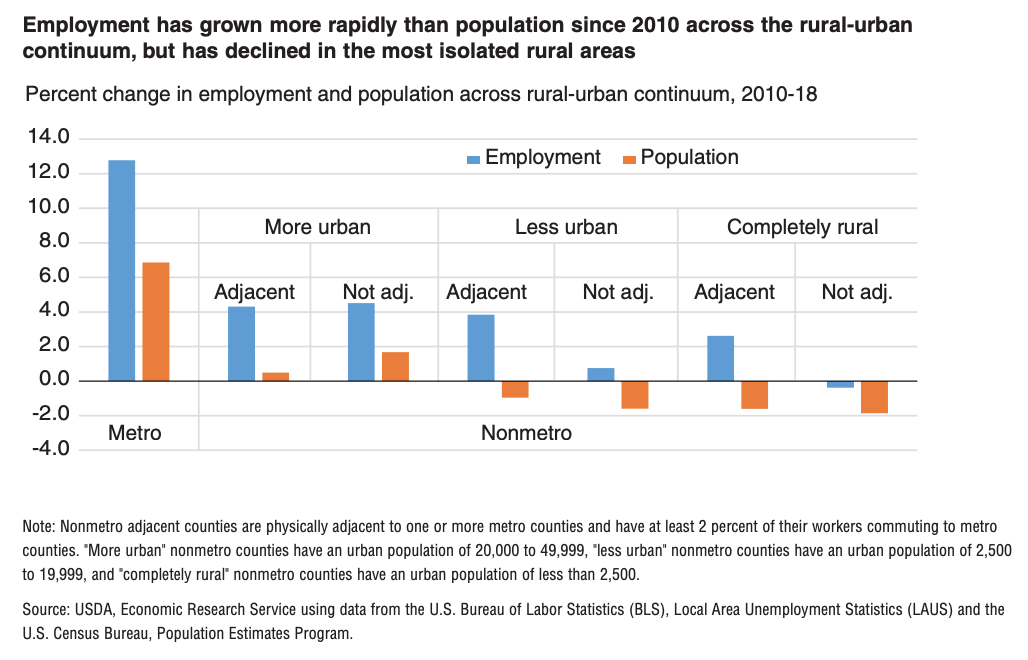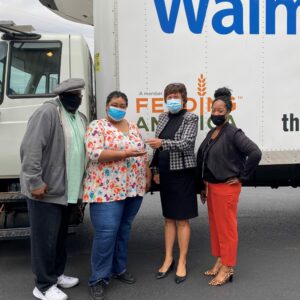Food insecurity persists in rural America as economic recovery is slow to appear
High unemployment, declining populations, and a lack of public transportation contribute to the rural-urban divide.
Written by: Emily Gallion, Grants & Advocacy Manager and Caitlyn McIntosh, Development Manager
In our cities, we see hunger every day. It looks like a huddle of people waiting for a pantry to open, or cracked hands holding a cardboard sign asking for money for food. It can even look like boards on the windows of a neighborhood’s last remaining grocery store.
Of the top 10 percent of US counties with the highest rates of food insecurity, 76 percent are rural. On average, 15 percent of households living in rural areas are food insecure, compared to 11.8 percent of people living in urban counties.
American economic recovery has made headlines recently: the national unemployment rate has dropped to 3.6% and the Dow Jones has reached record highs. However, economic growth has been patchy. While employment rates in metropolitan areas have surpassed pre-2008 levels, rural areas have not yet recovered.

The Foodbank serves three counties: Montgomery, Greene, and Preble. Montgomery County is considered an urban (or metropolitan) county. Preble County is a designated rural county. Greene County contains a mix of urban clusters and rural areas, and as a result is often categorized as a suburban or small-town county. Because rural-urban designations are made at the county level, overarching data can sometimes obscure the realities of the people who live in communities within them.
Within Preble county, 12% of adults and 18.8% of children are food insecure, according to Feeding America’s Map the Meal Gap. Households with children are more likely to experience food insecurity in general, but the trend is especially pronounced in rural communities.
A common theme when discussing rural hunger is the low population density and associated lack of resources. Rural areas have also seen population decreases as individuals move away- often termed “domestic migration.” While metropolitan areas experienced a population growth of over 6 percent from 2010 to 2018, according to American Community Survey data, the most rural areas saw decreases of almost 2 percent, which contributes to the ability of local businesses to remain open.
As a result of these population trends, in addition to difficulty affording food, people who are living in poverty in non-metropolitan areas often report challenges accessing food as grocery stores struggle to remain open.

According to The Ohio State University’s Center for Farmland Policy Innovation (CFPI), 24 percent of residents of rural Ohio have to drive at least 10 minutes to purchase food from a retailer — including convenience stores and other sellers that rarely provide an adequate selection of fresh food. Stores in this category that do sell fresh food have a reputation for doing so at inflated prices.
Additionally, not every household living within driving distance of a retail grocery store has the means to get to it. Of the households living within driving distance from a store, five percent do not own a car, and public transportation is extremely uncommon in non-metro areas.
For example, our clients living in Lewisburg must make the 11 minute drive to a grocery store in Brookville, or even 15 minutes to one in Eaton. However, if you do not have a car then you are left with options from the local convenience store in town, because there is no public transportation available.
Grocery stores are not the only resources that are sparse in rural counties. Nearly one million children living in Ohio’s rural counties live with no access to a pediatrician. This translates to one in three children who have to travel at least 40 minutes to the nearest provider. According to American Community Survey data, 152,000 Ohio children live in a home without a vehicle.
This is especially concerning given the impact food insecurity can have on children’s health. Children who are food insecure face increased rates of obesity, more frequent colds and stomach aches, behavioral health problems, and even developmental problems. Coupled with increased distances from healthcare providers, food insecurity is potentially dangerous for these children.
Knowing the impact food insecurity can have on the health of both children and adults, The Foodbank has taken steps in recent years to increase the availability of food in the rural areas we serve. While we are located in Dayton, we are constantly trying to expand our reach.
In fiscal year 2017, our pantries served a total of 5,056 clients in Preble county. At the close of our most recent fiscal year, we had increased that number to 11,151.
Another program we are using to meet this need is our Mobile Farmers Markets, which distribute fresh food directly in areas we identify as high need. We host four distributions in Preble County each month. This February, our mobiles served 1,157 people in Preble county alone.
For more information on our mobiles, come back for our next blog post about our Mobile Farmers Markets. Have suggestions for what posts you want to see in the future? Learn something cool today? Let us know in the comments below!




No comment yet, add your voice below!